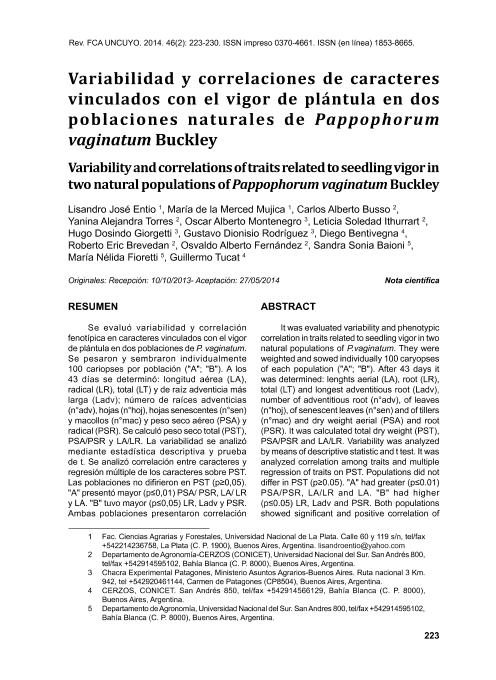Artículo
Se evaluó variabilidad y correlación fenotípica en caracteres vinculados con el vigor de plántula en dos poblaciones de P. vaginatum. Se pesaron y embraron individualmente
100 cariopses por población ("A"; "B"). A los 43 días se determinó: longitud aérea (LA), radical (LR), total (LT) y de raíz adventicia más larga (Ladv); número de raíces adventicias (n°adv), hojas (n°hoj), hojas senescentes (n°sen) y macollos (n°mac) y peso seco aéreo (PSA) y radical (PSR). Se calculó peso seco total (PST), PSA/PSR y LA/LR. La variabilidad se analizó mediante estadística descriptiva y prueba de t. Se analizó correlación entre caracteres y regresión múltiple de los caracteres sobre PST. Las poblaciones no difirieron en PST (p≥0,05). "A" presentó mayor (p≤0,01) PSA/ PSR, LA/ LR y LA. "B" tuvo mayor (p≤0,05) LR, Ladv y PSR. Ambas poblaciones presentaron correlación significativa y positiva del PST con LA, LT, Ladv, n°adv, n°hoj y n°mac. La regresión fue significativa (p≤0,01). La variabilidad encontrada dentro y entre las poblaciones implica expectativas de respuesta a la selección. PST varió sólo dentro de poblaciones sugiriendo la conveniencia de selección intrapoblacional. La asociación encontrada entre los caracteres LA y n°mac y el vigor de plántula, debería ser considerada en la mejora genética de la implantación. It was evaluated variability and phenotypic correlation in traits related to seedling vigor in two natural populations of P.vaginatum. They were weighted and sowed individually 100 caryopses of each population ("A"; "B"). After 43 days it was determined: lenghts aerial (LA), root (LR), total (LT) and longest adventitious root (Ladv), number of adventitious root (n°adv), of leaves (n°hoj), of senescent leaves (n°sen) and of tillers (n°mac) and dry weight aerial (PSA) and root (PSR). It was calculated total dry weight (PST), PSA/PSR and LA/LR. Variability was analyzed by means of descriptive statistic and t test. It was analyzed correlation among traits and multiple regression of traits on PST. Populations did not differ in PST (p≥0.05). "A" had greater (p≤0.01) PSA/PSR, LA/LR and LA. "B" had higher (p≤0.05) LR, Ladv and PSR. Both populations showed significant and positive correlation of PST with LA, LT, Ladv, n°adv, n°hoj y n°mac. The regression was significant (p≤0.01). The variability found within and between populations implies expectations of response to selection. PST varied only within populations suggesting the convenience of intrapopulation selection. The association found between the traits LA and n°mac and the seedling vigor, should be considered for the genetic improvement of the implantation.
Variabilidad y correlaciones de caracteres vinculados con el vigor de plántula en dos poblaciones naturales de Pappophorum vaginatum Buckley
Título:
Variability and correlations of traits related to seedling vigor in two natural populations of Pappophorum vaginatum Buckley
Entio, Lisandro Jose; Mujica, Maria de la Merced; Busso, Carlos Alberto ; Torres, Yanina Alejandra
; Torres, Yanina Alejandra ; Montenegro, Oscar Alberto; Ithurrart, Leticia Soledad
; Montenegro, Oscar Alberto; Ithurrart, Leticia Soledad ; Giorgetti, Hugo Dosindo; Rodriguez, Gustavo Dionisio; Bentivegna, Diego Javier
; Giorgetti, Hugo Dosindo; Rodriguez, Gustavo Dionisio; Bentivegna, Diego Javier ; Brevedan, Roberto
; Brevedan, Roberto ; Fernandez, Osvaldo Alberto
; Fernandez, Osvaldo Alberto ; Baioni, Sandra Sonia; Fioretti, Maria Nelida; Tucat, Guillermo
; Baioni, Sandra Sonia; Fioretti, Maria Nelida; Tucat, Guillermo
 ; Torres, Yanina Alejandra
; Torres, Yanina Alejandra ; Montenegro, Oscar Alberto; Ithurrart, Leticia Soledad
; Montenegro, Oscar Alberto; Ithurrart, Leticia Soledad ; Giorgetti, Hugo Dosindo; Rodriguez, Gustavo Dionisio; Bentivegna, Diego Javier
; Giorgetti, Hugo Dosindo; Rodriguez, Gustavo Dionisio; Bentivegna, Diego Javier ; Brevedan, Roberto
; Brevedan, Roberto ; Fernandez, Osvaldo Alberto
; Fernandez, Osvaldo Alberto ; Baioni, Sandra Sonia; Fioretti, Maria Nelida; Tucat, Guillermo
; Baioni, Sandra Sonia; Fioretti, Maria Nelida; Tucat, Guillermo
Fecha de publicación:
05/2014
Editorial:
Universidad Nacional de Cuyo
Revista:
Revista de la Facultad de Ciencias Agrarias de la Universidad Nacional de Cuyo
ISSN:
0370-4661
e-ISSN:
1853-8665
Idioma:
Español
Tipo de recurso:
Artículo publicado
Clasificación temática:
Resumen
Archivos asociados
Licencia
Identificadores
Colecciones
Articulos(CERZOS)
Articulos de CENTRO REC.NAT.RENOVABLES DE ZONA SEMIARIDA(I)
Articulos de CENTRO REC.NAT.RENOVABLES DE ZONA SEMIARIDA(I)
Citación
Entio, Lisandro Jose; Mujica, Maria de la Merced; Busso, Carlos Alberto; Torres, Yanina Alejandra; Montenegro, Oscar Alberto; et al.; Variabilidad y correlaciones de caracteres vinculados con el vigor de plántula en dos poblaciones naturales de Pappophorum vaginatum Buckley; Universidad Nacional de Cuyo; Revista de la Facultad de Ciencias Agrarias de la Universidad Nacional de Cuyo; 46; 2; 5-2014; 223-230
Compartir



